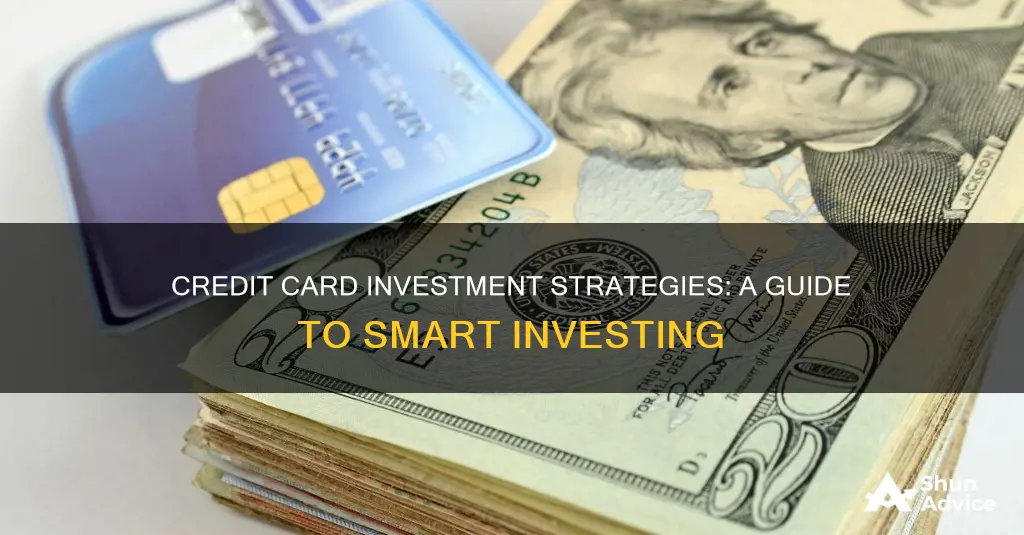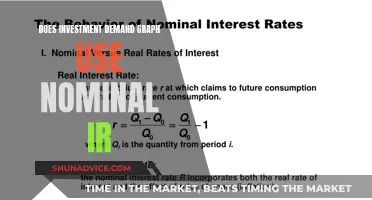
Investing in stocks using a credit card is risky and not recommended. While it is possible to use a credit card to buy stocks, it is generally not a good idea due to the potential for high fees and negative impacts on your credit score. Most brokerage firms do not allow direct funding of accounts with a credit card, and there are safer ways to invest, such as using a margin account to borrow money at a lower rate than credit cards. If you are being pressured to use a credit card, it is likely a scam.
| Characteristics | Values |
|---|---|
| Risks | Poor investments, creating a debt habit, defaulting on the loan, credit score setbacks, rule changes, fraud, losing money, scam |
| Rewards | Credit card rewards, welcome bonuses, cash-back credit cards, sign-up bonus, tax advantages |
| Fees | Investment fees, cash advance fees, late payment fees, interest fees, balance transfer fee, processing fee, cash advance fee |
| Apps | Stockpile, Acorns, Stash |
| Alternatives | Bank transfer, check, wire transfer, cash-back credit cards, brokerage account, margin account |
What You'll Learn

Understand the risks
Investing with credit cards is risky, and it's essential to understand the potential drawbacks before proceeding. Here are some key risks to consider:
Poor Investments
Finding a "safe" investment that offers a higher interest rate than what you're paying on your credit card can be challenging, especially in a difficult financial environment. Investment professionals are typically better equipped to find such opportunities. If the investment underperforms or loses value, you will still have to repay your credit card debt, potentially at a high interest rate.
Creating a Debt Habit
Engaging in credit card arbitrage can encourage a habit of carrying high levels of debt. It can foster a mentality of spending beyond your means and relying on credit to fund investments. This behaviour can be financially unhealthy and lead to poor financial decisions.
Defaulting on the Loan
If you fail to repay the credit card company according to the loan terms, you will be in default. This can result in late fees and penalty interest rates, which can quickly mount up and outweigh any potential investment gains. Defaulting on the loan can leave you with significant debt that may take months or years to repay.
Credit Score Setbacks
Using credit cards for investments can negatively impact your credit score in several ways. Opening a new line of credit and increasing your credit utilisation ratio (the amount of credit used relative to the total credit limit) can lower your score. Additionally, a high debt-to-income ratio, even if it's not on your credit report, can affect your ability to obtain other loans, such as mortgages. Late or missed payments can also significantly damage your credit score.
Rule Changes
Credit card companies can change the terms of your agreement at any time, and they are not required to provide advance notice. They may modify your payment due date, shorten your billing cycle, increase your interest rate, or add fees. These changes can significantly impact your investment strategy and profitability.
Additional Fees and Tax Implications
When investing with credit cards, various fees can eat into your profits, including investment fees, cash advance fees, late payment fees, and interest charges. Additionally, your stock investments may be subject to capital gains taxes, further reducing your profits. It's crucial to understand all the costs involved before proceeding.
Renting: Is Cash Payment an Investment Strategy?
You may want to see also

Avoid creating a debt habit
Investing using credit cards can be a risky move, and it's important to be aware of the potential pitfalls before making any decisions. One of the main risks is creating a debt habit, which can have serious financial and psychological consequences. Here are some tips to help you avoid falling into a debt trap when investing with credit cards:
Understand the Risks
Before using credit cards for investing, it's crucial to understand the risks involved. Credit card debt can be a dangerous habit to fall into, and it's important to recognize the potential impact on your financial health and well-being. High-interest rates, late fees, and compound interest can quickly turn a small debt into a much larger one.
Don't Carry a Balance
One of the best ways to avoid credit card debt is to pay off your balance in full each month. This maintains your grace period, an interest-free window offered by many credit card companies between the time of purchase and the payment due date. If you lose your grace period by carrying a balance, you'll start accruing interest on all your purchases, which can quickly snowball into significant debt.
Make at Least the Minimum Payment
If you can't pay off your balance in full, be sure to make at least the minimum payment to keep your account in good standing. Missing a minimum payment can hurt your credit score and result in late fees and interest charges. Contact your credit card company if you're having trouble making payments—they may be willing to waive fees or lower your interest rate, especially if you're a longtime customer.
Prioritize Credit Card Debt
If you're already carrying credit card debt, make it a priority to pay it off before investing. Credit card debt often comes with high-interest rates, which can negate any gains you make from your investments. Focus on paying off your credit card debt first, then redirect your funds towards investing once you've eliminated that burden.
Maintain a Healthy Perspective
It's important to recognize that investing with credit cards is a risky strategy. Don't fall into the trap of thinking that investing with credit cards is a sustainable long-term solution. While it may be tempting to take advantage of rewards or arbitrage opportunities, the potential gains rarely outweigh the risks. Keep your investments and spending within a healthy range relative to your income and financial goals.
Understanding the Investing Activities on a Cash Flow Statement
You may want to see also

Be aware of investment fees
When investing using a credit card, you will likely encounter various fees that can eat into your profits.
Investment Fees
Currently, only one investment app, Stockpile, allows credit card usage for stock purchases, and it charges a 3% fee. However, that's not the only fee you have to consider. You may also have to pay cash advance fees, late payment fees if you don't pay your card on time, and interest fees if your balance isn't paid off every month. These fees can quickly add up and get expensive.
Cash Advance Fees
Most credit cards charge a cash advance fee, typically ranging from 3% to 5% of the requested amount, when you use your card to access cash. This fee applies when you transfer funds from your credit card to your bank account, which you then invest.
Interest Rates
The interest you pay on credit card purchases might significantly reduce any return on your investment. For example, if your investment yields a 10% return, but you pay a 15% interest rate on your credit card purchases, you will owe more money than you made on your investment, assuming you don't pay off your credit card balance before interest accrues. Therefore, it is crucial to pay off your credit card debt before making investment decisions.
Transaction Fees
Credit card companies usually charge a processing fee, often ranging from 1.5% to 3%, for each transaction. If you use your credit card to buy an investment, you will have to pay this fee with each investment purchase, impacting the overall return.
In summary, investing using a credit card can be risky due to the various fees involved. It is essential to carefully consider these fees and understand the potential impact on your investment returns.
Transferring Cash to Invest on Stash: A Step-by-Step Guide
You may want to see also

Consider the tax implications
When investing using a credit card, it's important to consider the tax implications. In the US, the Internal Revenue Service (IRS) doesn't provide clear guidance on the tax treatment of credit card rewards. However, as a general rule, any income received by a taxpayer is subject to tax. The type of reward and how it is received will be the main factor in determining whether it is taxable.
Credit card rewards are typically considered non-taxable rebates. For example, rewards earned through travel or airline miles, regular purchases, and cash back applied as a credit balance are usually non-taxable. On the other hand, rewards provided as an incentive for opening an account without any spending requirement may be considered taxable income. Sign-up bonuses can go either way—if they are paid out in cash, they are more likely to be treated as taxable income.
If you earn $600 or more in rewards in a year, your credit card company will send you a 1099-MISC form, which indicates that the rewards are taxable income. Even if you earn less than $600, you are still required to report the income and may have to pay taxes on it.
When investing with a credit card, you may also need to consider the tax implications of capital gains. If you buy stocks using a credit card and then sell them at a profit, you may be subject to capital gains tax. The holding period will impact the tax rate.
Additionally, interest charges on credit cards used for personal purchases are generally not tax-deductible. However, if you use a credit card for business purposes and accrue interest charges, those payments may be deductible as a business expense.
Understanding Invested Assets: Does Cash Count?
You may want to see also

Use an investment app
Using an Investment App to Invest with a Credit Card
Using an investment app is one way to invest with a credit card, although it is a risky strategy.
Stockpile App
The Stockpile app allows you to buy fractional shares using gift cards, which can be purchased with a Visa or Mastercard credit card. However, there are several fees to be aware of when using this method. Stockpile charges a 3% fee and a $0.99 trading fee when buying and selling. You may also be charged cash advance fees, late payment fees, and interest fees if you do not pay off your credit card balance each month.
Other Investment Apps
There are other investment apps that allow you to fund your brokerage account with a credit card, although you will likely incur similar fees. It is important to do your research and carefully consider the risks and fees involved before investing with a credit card.
Cash Transfers: A Better Investment for the Future
You may want to see also
Frequently asked questions
Investing in stocks using a credit card can be risky as it can cost you more than you can afford. You may end up paying extra fees, such as investment fees, cash advance fees, late payment fees, and interest fees. It can also negatively impact your credit score and lead to high-interest debt.
There are a few safer alternatives to investing in stocks using a credit card. You can use a credit card to fund a brokerage account, invest through an investment app, or open a credit card that invests rewards.
Before investing in stocks using a credit card, it is important to do your research and consider the risks. Be mindful of any fees, such as investment fees, cash advance fees, and late payment fees. Also, make sure you understand the cost of using a credit card and the cost of trading.
There are a few ways to invest in stocks using a credit card. You can purchase a gift card for Stockpile, an online brokerage that lets you buy fractional shares, or use a credit card to transfer funds into your checking account and then transfer the money to a brokerage account.







